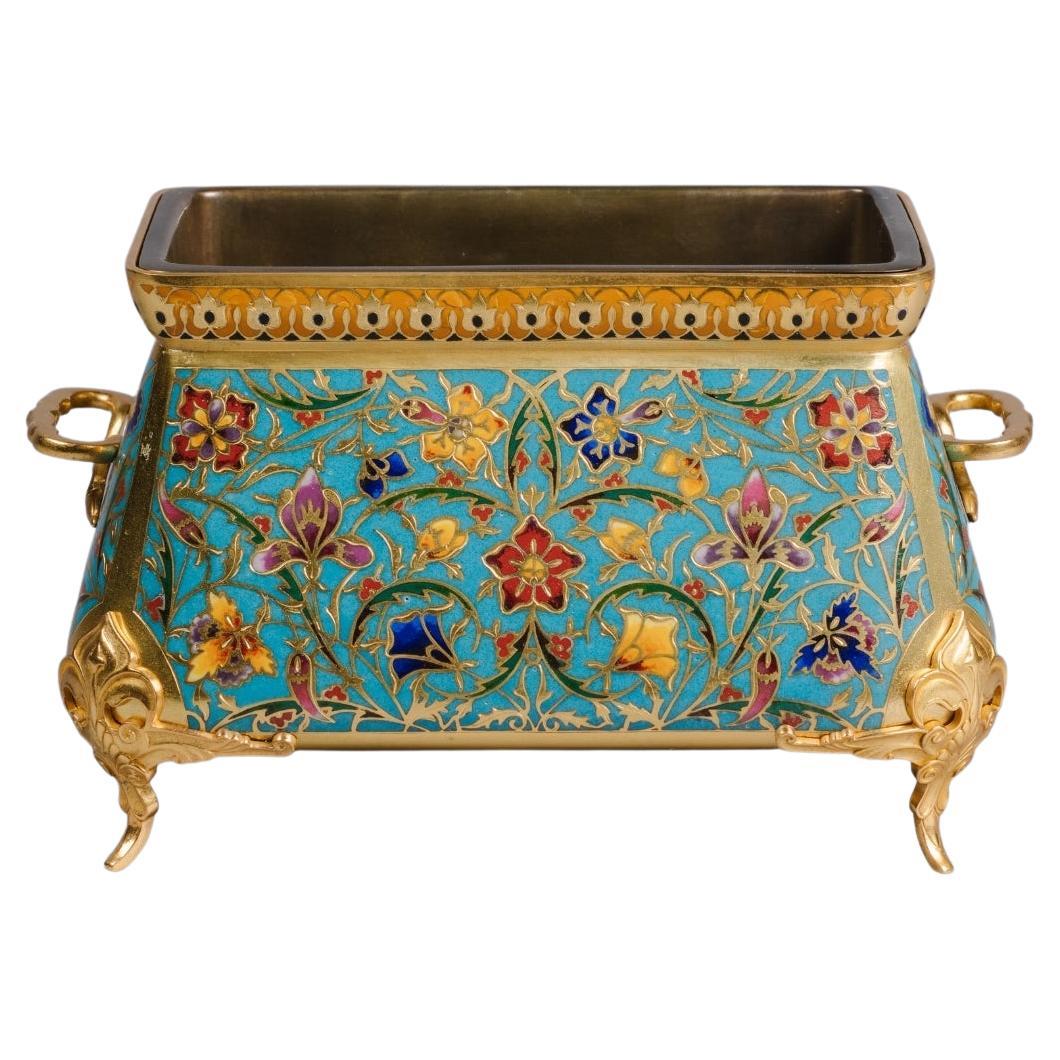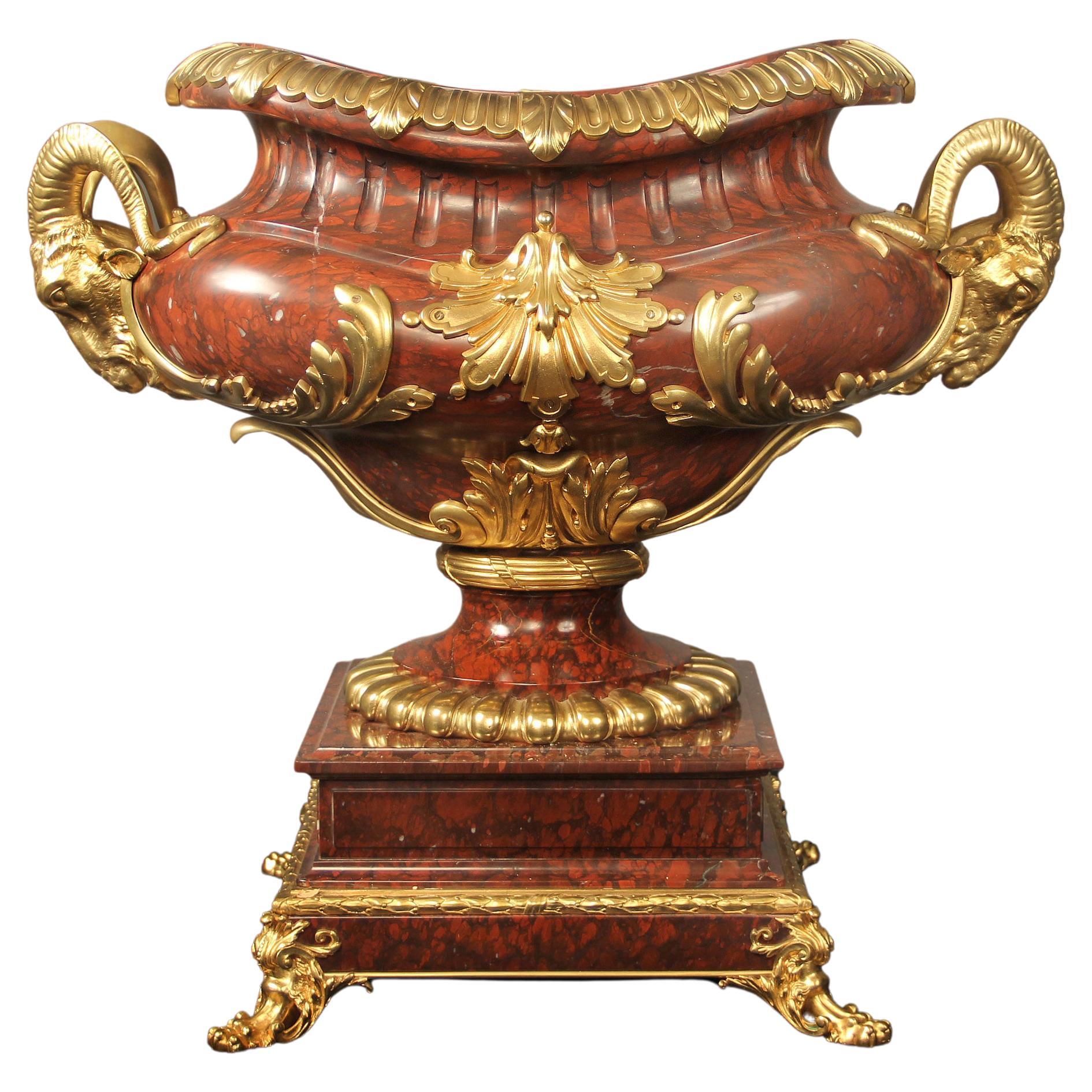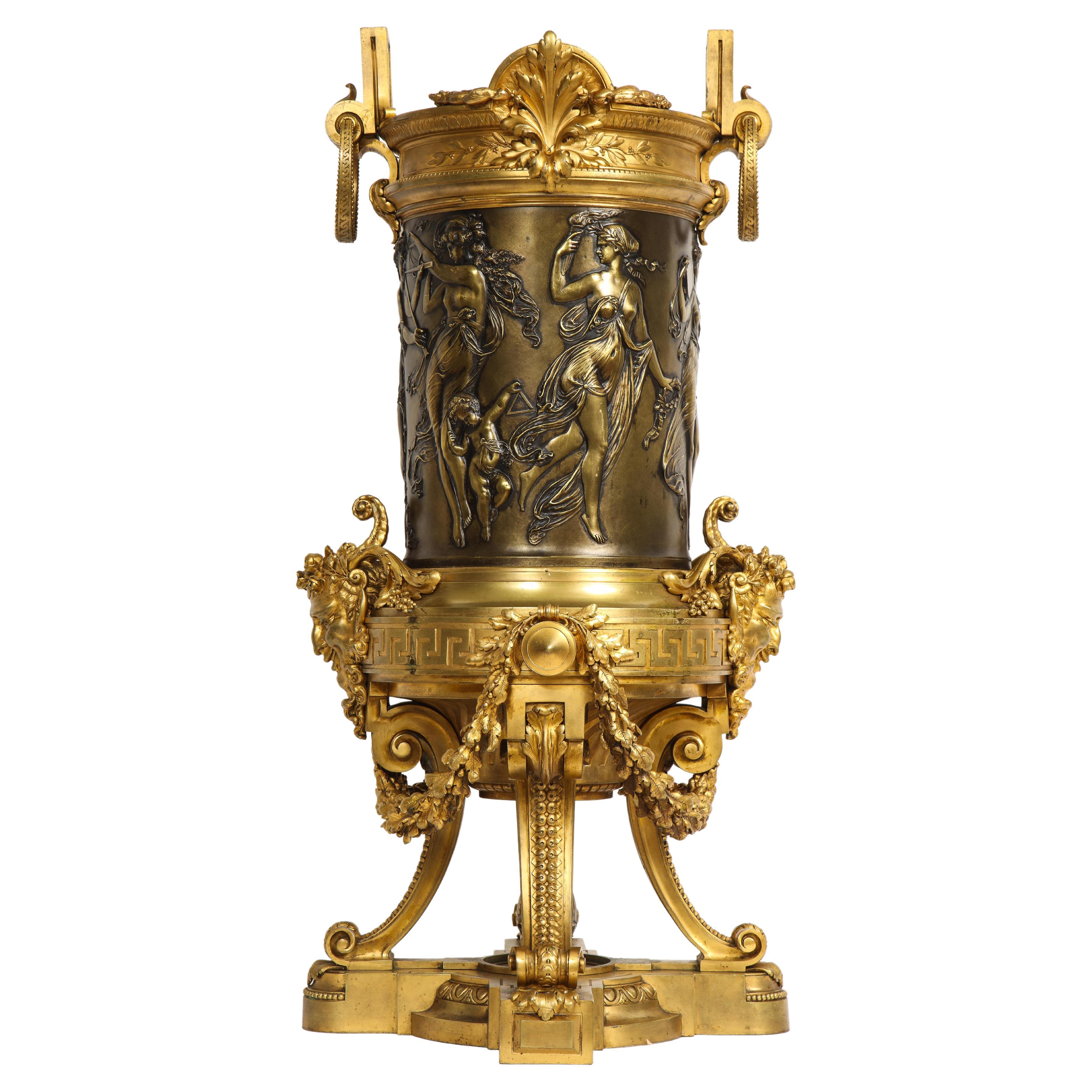19th Century Silvered Bronze Athénienne Jardinière by Ferdinand Barbedienne
About the Item
- Creator:Ferdinand Barbedienne (Maker)
- Dimensions:Height: 40.56 in (103 cm)Diameter: 16.34 in (41.5 cm)
- Style:Grand Tour (Of the Period)
- Materials and Techniques:
- Place of Origin:
- Period:
- Date of Manufacture:1860
- Condition:Wear consistent with age and use.
- Seller Location:Oxfordshire, GB
- Reference Number:1stDibs: LU4936227272632
Ferdinand Barbedienne
Founded by one-time Parisian wallpaper dealer Ferdinand Barbedienne and engineer Achille Collas, one of the most revered foundries in 19th-century France began with the invention of a revolutionary 1830s-era device that could produce proportional reproductions — large or small — of sculptures. Collas’s machine, which yielded miniature likenesses of antiquities for the interiors of homes the world over, was pivotal to the success of the F. Barbedienne Foundry. The successful firm earned prestigious awards and critical acclaim and created exquisite bronze candleholders, clocks and lamps for a range of wealthy and prominent clients.
The duo first launched their company under the name Société Collas et Barbedienne, and early on, they optimized chemical processes for pigmenting and patinating their bronze statuettes. After Collas died in 1859, Barbedienne forged on alone, and the company’s name changed to simply F. Barbedienne.
Barbedienne employed more than 300 workers at that point, and the Maison created a range of furnishings and decorative objects that featured the integration of marble and ormolu accents. However, with the onset of the Franco-Prussian War of 1870, the foundry was forced to retrofit its molds, and the production of cannons replaced sculptures, furniture and vases.
When Ferdinand Barbedienne passed away in 1891, his nephew and heir, Gustave Leblanc, took over as president, changing the name to Leblanc-Barbedienne. Leblanc expanded production into Germany, the United Kingdom and the United States, carrying on the company's legacy with monumental sculptures, and models and securing production rights for famous statues. Paul-Alexandre Dumas, an Art Nouveau maker and student of Louis Majorelle, succeeded Leblanc until the company's closing in 1952.
Barbedienne pieces had been exhibited regularly in the 19th century and were especially prevalent at Europe’s international expositions and world’s fairs, where they received numerous prizes. Today, the Musée d’Orsay in Paris holds dozens of Barbedienne works in its collection, including intricate mirrors, vases and cups created by Louis-Constant Sévin at the foundry. For more than two decades, Sévin created lamps, boxes and more at Maison Barbedienne. Working alongside award-winning chaser Désiré Attarge, Sévin designed Napoleon III-era works that greatly appealed to European nobility.
Other notable artists who collaborated with Barbedienne included Eugene Aizelin, Emmanuel Fremiet, Antonin Mercié, Emile Guillemin, Edouard Lievre, Ferdinand Levillain and Auguste Rodin.
On 1stDibs, find a collection of antique Ferdinand Barbedienne decorative objects, lighting and more.
- ShippingRetrieving quote...Ships From: Faringdon , United Kingdom
- Return PolicyA return for this item may be initiated within 14 days of delivery.
- 19th Century Grand Tour Micro Mosaic Tablet Depicting Italian ArchitectureLocated in Oxfordshire, United KingdomA fine mid-19th century serpentine grand tour micro mosaic tablet or paperweight of the iconic St Peter's Vatican, The Colosseum of Rome, The Pantheon, The Ruins of The Roman Forum a...Category
Antique Early 19th Century Italian Grand Tour Decorative Art
MaterialsBelgian Black Marble
- An unusual late 17th early 18th century Delft jugLocated in Oxfordshire, United KingdomA Rare and Highly Attractive Late 17th/Early 18th Century Delft Jug with Loop Handle. Circa 1690-1710 The body painted in a naive manner with medallions of ...Category
Antique 1740s Danish Dutch Colonial Vases
MaterialsClay
- Robert Adam George III Silver Gilt Vase by Daniel Smith and Robert Sharp LondonBy Daniel Smith & Robert Sharp, Robert AdamLocated in Oxfordshire, United KingdomA fine and rare 18th century George III silver-gilt vase by Daniel Smith and Robert Sharp, London 1770. Based on a design by the Italian printmaker Stefano della Bella (1610-1664). The design was adapted by the architect Robert Adam (1728-1792). The overall form of the vase and some of the ornaments, such as the drapery swags, figural masks and acanthus leaves on the body, are based on a design by the Italian printmaker Stefano della Bella (1610-1664). He produced about 1,400 prints during his lifetime which were very influential, particularly a series of designs for vases in Raccolta di Vasi Diversi, published between 1639 and 1648. The design was adapted by the architect Robert Adam (1728-1792), whose drawing, now in Sir John Soane's Museum in London and was copied by the highly-fashionable silversmithing partnership Daniel Smith and Robert Sharp. Daniel Smith and Robert Sharp’s partnership ran from 1763-1788. They supplied high-quality silver and silver gilt in the Neo-classical style to the most fashionable retailers and clients, including the Prince Regent. They were the principal manufacturers of a series of magnificent race cups, one of which was designed by the architect Robert Adam (1728-1792) and another is in the Royal collection Robert Adam (1728-1792) was arguably the most famous eighteenth century British architect and designer, whose remarkable career in partnership with his brothers James and William has been thoroughly documented elsewhere and whose major commissions can still be seen at Harewood House...Category
Antique 18th Century English Adam Style Vases
MaterialsSilver
- 19th-Century Flame Mahogany Mantel Clock by Breguet Raised by Lion Paw FeetBy Breguet a ParisLocated in Oxfordshire, United KingdomAn extremely rare mantel clock with a figured mahogany-veneered case by A-L Breguet Abraham-Louis Breguet (1747-1823), who was of Swiss origin, is undoubtedly the most celebrated clockmaker of the late eighteenth and early nineteenth centuries in France. He is responsible for the invention of the self-winding watch, the tourbillon and the sympathetic watch ( a watch that is placed in a cradle of a special clock. It is then linked by means of a pin fixed behind the clock dial. Built into the motion work which, when released by the clock, automatically sets the hands to the clock's time as well as correcting the watch's regulator necessitated by any degree of inaccuracy registered at the moment of synchronisation) and many other horological improvements and developments. Around the year 1807 Breguet brought in his son, Antoine-Louis (born 1776), as a business partner, and from this point, the firm became known as Breguet et Fils. Breguet had previously sent his son to London to study with the great English chronometer maker John Arnold...Category
Antique Late 18th Century French Empire Mantel Clocks
MaterialsBrass
- Striking 19th Century Carriage Clock with a Gilt-Brass Corniche Case by GrohéLocated in Oxfordshire, United KingdomStriking carriage clock with a gilt-brass corniche case by Grohé, circa 1880. A most attractive eight-day striking carriage clock, signed on...Category
Antique 19th Century French Neoclassical Carriage Clocks and Travel Clocks
MaterialsBrass
- Fine 19th century French ormolu mantel clock (pendule) by Leroy a Paris, c. 1825By LeRoyLocated in Oxfordshire, United KingdomA most beautiful French ornolu mantel clock by Leroy à Paris A lovely French late Empire/early Charles X mantel clock with an ormolu case, c. 1825. The ormolu brass case depicts a celebration of Science and Learning. It is dominated by a rectangular superstructure containing the movement, flanked by an engine-turned column with a celestial globe on top on the left and an elegant lady reading a book on the right. The superstructure is surmounted by a bookcase and a bust of Socrates...Category
Antique Early 19th Century French Empire Mantel Clocks
MaterialsBrass, Ormolu
- Ferdinand Barbedienne Bronze Boy & Goose Sculpture 19th CenturyBy Ferdinand BarbedienneLocated in Bishop's Stortford, HertfordshireA finely patinated French antique bronze by Ferdinand Barbedienne portraying a a young boy caressing a large goose. The figure is mounted on an angled and shaped base and is signed '...Category
Antique 19th Century French Napoleon III Animal Sculptures
MaterialsBronze
- Ferdinand Barbedienne " Diana" Sculpture, 19th CenturyBy Ferdinand BarbedienneLocated in Madrid, ES"Diane de Gabies" French sculpture, late 19th century. Patinated bronze with "Ferdinand Barbedienne" foundry marks. Height: 51 cm. Very good condition.Category
Antique 19th Century French Baroque Figurative Sculptures
MaterialsBronze
- A Champlevé Enamel Jardinière by Ferdinand BarbedienneBy Louis-Constant Sevin, Ferdinand BarbedienneLocated in Brighton, West SussexA Champlevé Enamel and Gilt-Bronze Mounted Jardinière by Ferdinand Barbedienne, the design attributed to Louis-Constant Sévin. This fine jardinière is decorated all over with foliate...Category
Antique 19th Century French Planters, Cachepots and Jardinières
MaterialsBronze, Enamel
- Imposing 19th Century Bronze Mounted Rouge Marble Jardiniere by BarbedienneBy Ferdinand BarbedienneLocated in New York, NYAn imposing late 19th century Napoleon III gilt bronze mounted rouge griotte marble jardiniere by Barbedienne Ferdinand Barbedienne The oval waisted neck with gadrooned surroun...Category
Antique 19th Century French Belle Époque Centerpieces
MaterialsGriotte Marble, Bronze
- A 19th C. French Louis XVI Patinated & Doré Bronze Jardinière, F. BarbedienneBy Ferdinand BarbedienneLocated in New York, NYA Magnificent and Large 19th Century French Louis XVI Style Patinated and Doré Bronze Jardinière/Planter, Attributed to F. Barbedienne The large and imposing piece features a regal ...Category
Antique 19th Century French Louis XVI Planters, Cachepots and Jardinières
MaterialsBronze
- Early 20th Century Gilt Bronze "Decorative Vases" by Ferdinand BarbedienneBy Ferdinand BarbedienneLocated in London, GBA highly attractive pair of late 19th century gilt bronze twin handled vases. The handles in the form of twisted vines and the vases decorated with butterflies and birds with snails ...Category
Early 20th Century French Art Nouveau Vases
MaterialsMarble, Gold, Bronze






